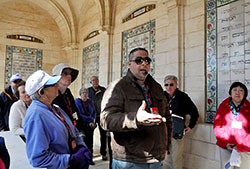Tour guide gives pilgrims cultural, historical and archaeological insight on Scripture

Tour guide Tony Azraq, a Palestinian Melkite Catholic, recites the Our Father in Hebrew at the Church of the Pater Noster on the Mount of Olives as the pilgrims listen on Feb. 10. (Photo by Natalie Hoefer)
By Natalie Hoefer
GALILEE and JERUSALEM REGIONS, ISRAEL—The members of the archdiocesan pilgrimage to the Holy Land did not merely shuttle from place to place in Israel and the West Bank.
They were informed and enlightened by a tour guide with a unique perspective: Tony Azraq, a devout Melkite Catholic who works as an archaeologist and has lived in the Old City of Jerusalem all of his 39 years of life.
His insights on the history, archaeology and culture of the region provided the pilgrims a new perspective on Scripture.
Below are some of those insights to help readers of The Criterion share in the knowledge gained on the pilgrimage.
During the time of Christ, Caesarea Philippi was a large city built upon a bluff with a rock face about 500 feet long and 100 feet wide. According to Matthew 16:13-18, this is where Christ declared that Peter was “rock, and upon this rock I will build my Church, and the gates of the netherworld will not prevail against it.”
Standing against the base of the rock in the time of Christ was a temple built to the god Pan where children were sacrificed. Azraq believes knowledge about this location can shed light on Jesus’ statement.
“So Jesus said Peter was like the huge rock of Caesarea Philippi, but no gate of hell would stand against the rock of Peter like the evil temple that stood against the rock [of Caesarea Philippi].”
At the Basilica of the Annunciation in Nazareth that houses the underground room where it is believed the Annunciation took place, Azraq explained that one of the uses of such rooms was for women during times when they were considered ritually impure once a month. He offered an explanation as to why Mary was “troubled” at the words of the angel Gabriel, as stated in Luke 1:29.
“Forget about angel wings and halos. There was only one way into these underground rooms. Imagine you have a basement, and there’s only one set of stairs leading to it, and they lead from the kitchen. And you go up the stairs, leaving the basement empty, to get a drink from the fridge. You’re the only one there. And you go back downstairs, and you see a man standing down there, and he says, ‘Hi!’ As a woman alone in that room, you would be terrified!”
According to Azraq, springs existed in Jericho in the time of Christ, making the land fertile and plentiful. Indeed, Jericho is a stretch of green in an otherwise barren area.
Looming over Jericho is the Mount of Temptation, an almost lifeless desert mountain.
Azraq explained why, if this was indeed where Christ was tempted for 40 days, his suffering would have been greater on the mountain than in a flat desert.
“You hear Jesus went to the desert and you think there isn’t much there to tempt him. If you’re locked in a room with no food, there is nothing to tempt you. But he came to this desert mountain with all that he could not have lying right below him in full view, like locking yourself in a room full of everything you like to eat while trying to fast. This would be the hard temptation.”
Azraq explained a custom during Roman times in which tears would be collected in a small vial throughout one’s life and placed in their tomb upon death. Azraq attested to finding such vials in excavated tombs. He believes this could shed light on Luke 7:38, which describes how a sinful woman washed Jesus’ feet with her tears.
“She likely used the vial of her tears, giving all her sorrows and joys in life to Christ, giving her life, herself, to Christ.” †
Related story: Life for Catholics in Holy Land involves persecution and economic hardship
